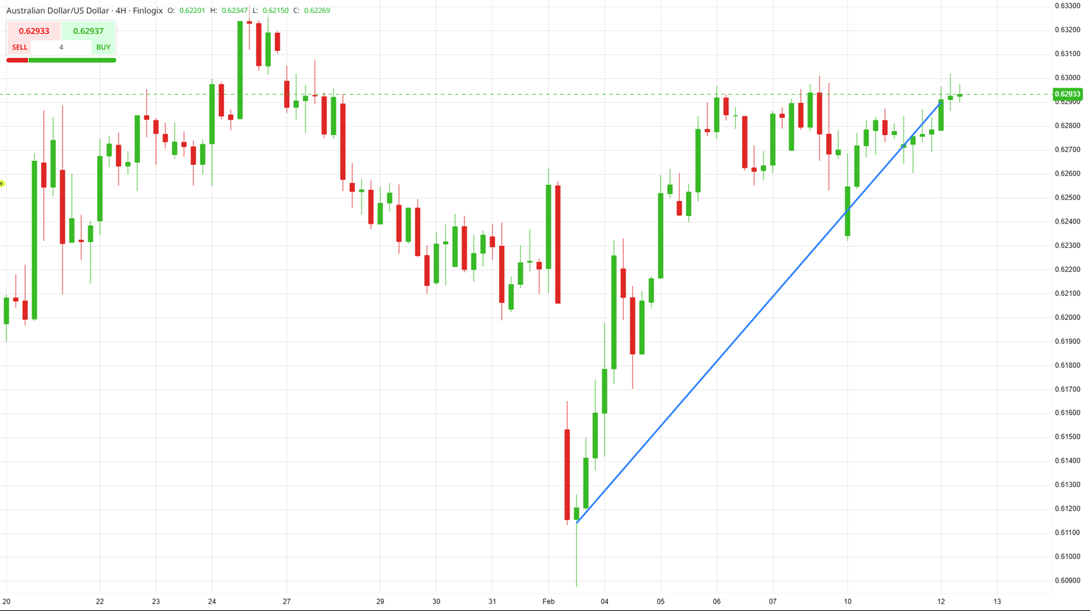
Tariffs on Steel and Aluminium the Real Implications on FX
 ACY Securities - Luca Santos
ACY Securities - Luca Santos
The FX market has entered a "wait and see" phase following President Trump's confirmation of new tariff hikes on steel and aluminium. Effective March 12, a 25% tariff will apply to all imports of these metals without exceptions—at least initially. The White House emphasized that this move aims to revive domestic manufacturing and protect American industry. However, President Trump has hinted at a possible exemption for Australia, citing the country’s substantial investment in the U.S. steel sector and its critical role in defence manufacturing. I’ve done a blog yesterday mentioning how it would work, you can find the blog HERE
AUD Strengths Against USD on Opening

Policy Rationale and Market Impacts
The administration justifies these tariffs under Section 232 of the Trade Expansion Act, framing them as a national security measure (If you would like to read the full article CLICK HERE). Unlike the 2018 tariffs that mainly targeted raw materials, the new round extends to finished products, such as extrusions and slabs, which could have broader implications for U.S. consumers and manufacturers. The administration argues that past exemptions were exploited by exporters, prompting a more comprehensive approach this time.
Financial markets have so far taken a measured response. The U.S. dollar has held steady, supported by strong nonfarm payroll figures, which suggest continued economic resilience. Meanwhile, the Australian dollar—despite speculation over a potential exemption—remains one of the top-performing G10 currencies this year, buoyed by rising commodity prices.
Lessons from 2018 and Global Reactions
A key question is how trading partners will respond. The European Union retaliated in 2018 by imposing tariffs on iconic American goods, including motorcycles and denim. Meanwhile, past U.S. tariff measures have proven costly; an analysis by the Peterson Institute for International Economics estimated that the 2018 steel and aluminium tariffs resulted in a per-job cost of approximately $650,000 due to higher consumer prices and reduced manufacturing competitiveness.
Emerging markets could face heightened risks. The Trump administration has announced "reciprocal tariffs," meaning countries imposing higher import duties on U.S. goods than vice versa could be targeted next. This disproportionately affects nations like India, Thailand, Argentina, South Africa, and Brazil, all of which maintain relatively high tariff structures. The recent appreciation of several emerging market currencies, such as the Brazilian real and Chilean peso, may be tested if trade tensions escalate.
The Road Ahead: Fed Policy and Political Considerations
With the Federal Reserve maintaining a cautious stance on rate cuts amid strong labour data, the tariff debate injects another layer of uncertainty into the economic outlook. Historically, higher tariffs have led to increased inflationary pressures, which could complicate the Fed’s decision-making process.
No cuts Expected by FED Until July 2025

Additionally, political factors cannot be ignored. The Australian government is pushing hard for an exemption ahead of its upcoming election, arguing that Australian steel is a critical input for U.S. manufacturing, particularly in defence-related sectors. Meanwhile, Trump’s aggressive trade policy plays into his broader election-year strategy, reinforcing his "America First" stance while setting the stage for potential negotiations.
The latest steel and aluminium tariffs mark a significant shift in U.S. trade policy, potentially straining relations with key allies and disrupting global supply chains. While markets remain calm for now, the real test will come in March when the tariffs take effect. How other nations respond—and whether exemptions are ultimately granted—will shape the trajectory of global trade in the months ahead. Traders and policymakers alike should brace for volatility as the situation unfolds. I do believe on a potential long on AUD if Trump decides to not go ahead with tariffs in Australia on March 12.
This content may have been written by a third party. ACY makes no representation or warranty and assumes no liability as to the accuracy or completeness of the information provided, nor any loss arising from any investment based on a recommendation, forecast or other information supplies by any third-party. This content is information only, and does not constitute financial, investment or other advice on which you can rely.
LiquidityFinder
LiquidityFinder was created to take the friction out of the process of sourcing Business to Business (B2B) liquidity; to become the central reference point for liquidity in OTC electronic markets, and the means to access them. Our mission is to provide streamlined modern solutions and share valuable insight and knowledge that benefit our users.
If you would like to contribute to our website or wish to contact us, please click here or you can email us directly at press@liquidityfinder.com.
